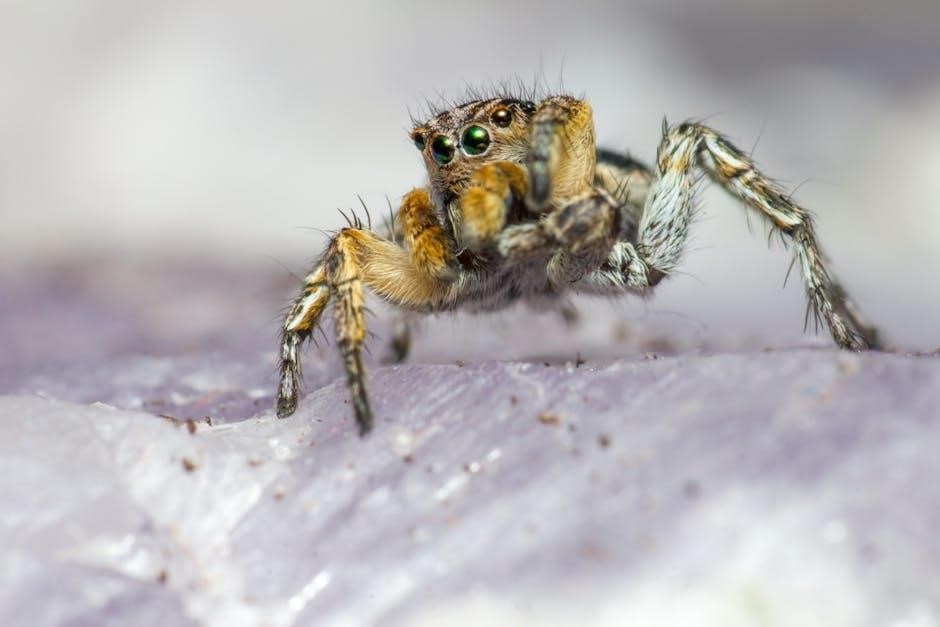Jumping spiders are popular pets known for their vibrant colors and active hunting style. Proper feeding is essential for their health, growth, and energy. They primarily consume live insects like crickets and flies, requiring a balanced diet to thrive. Understanding their feeding needs helps owners provide optimal care and ensure their well-being.
1.1. Overview of Jumping Spiders as Pets
Jumping spiders, like the popular Phidippus regius, are vibrant, small, and low-maintenance pets. Known for their striking colors and active hunting style, they captivate enthusiasts. Their curious nature and relatively small size make them ideal for keeping in terrariums. With proper care, jumping spiders can thrive, offering an engaging and unique pet experience for arachnophiles and beginners alike.
1.2. Importance of Proper Feeding for Health and Growth
Proper feeding is crucial for jumping spiders’ health and growth. A balanced diet ensures they receive essential nutrients for energy and development. Inadequate feeding can lead to weight loss, lethargy, and stunted growth. Regular, nutritious meals support their active hunting lifestyle and overall well-being, making feeding a cornerstone of responsible jumping spider care.
Recommended Food Sources for Jumping Spiders
Jumping spiders thrive on live insects like crickets, flies, and roaches. They also enjoy mealworms, waxworms, and fruit flies as alternative options. These foods are nutritious and easy to maintain, ensuring a balanced diet for optimal health.
2.1. Live Insects: Crickets, Flies, and Roaches
Live insects like crickets, flies, and roaches are ideal for jumping spiders. Crickets provide robust protein, while flies are easy to digest. Roaches are another nutritious option, offering a varied diet. These insects are widely available, making them convenient for feeding. It’s important to gut-load them with nutrient-rich foods before offering to ensure optimal nutrition for the spider.
2.2. Alternative Foods: Mealworms, Waxworms, and Fruit Flies
Mealworms, waxworms, and fruit flies are excellent alternatives for feeding jumping spiders. Mealworms and waxworms are high in protein and fat, serving as occasional treats. Fruit flies are smaller and ideal for juvenile spiders or species with smaller mouthparts. These options provide diversity in the diet, ensuring a balanced intake of nutrients without the need for live prey at every feeding session.
2.3. Feeding Fruits and Nectar as Supplements
Jumping spiders can enjoy fresh fruits like watermelon, strawberries, grapes, and mangoes as occasional treats. The sweet nectar from these fruits provides a natural source of sugar, offering a tasty supplement to their diet. This treat is not a replacement for their primary insect-based meals but adds variety and a quick energy boost. Use clean, ripe fruits to ensure safety and palatability for your pet spider.
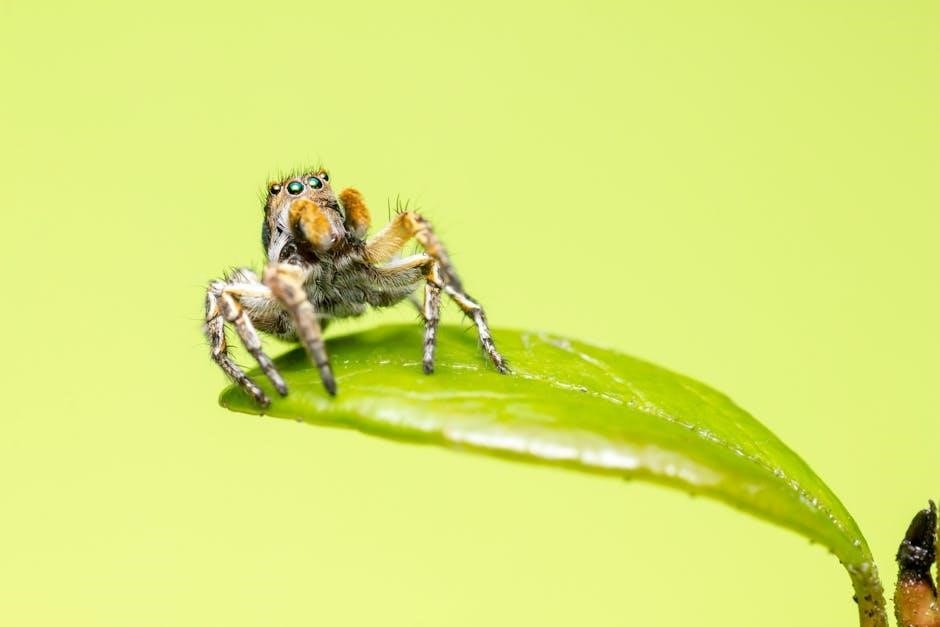
Feeding Techniques and Tools
Effective feeding tools include tweezers for offering live prey and feeding dishes to contain food. A paintbrush can also help immobilize prey for skittish spiders, ensuring safe feeding.
3.1. Using Tweezers for Feeding
Using tweezers is a popular method for feeding jumping spiders, as it allows precise control when offering live prey. Gently hold the insect by the legs or antennae, ensuring it remains immobile. This technique minimizes stress on the spider and prevents prey from escaping. Tweezers are especially useful for smaller spiders or skittish individuals that may hesitate to approach food placed in a dish. Regular cleaning of tweezers is essential to maintain hygiene and prevent contamination.
3.2. Feeding Dishes for Safe and Convenient Feeding
Feeding dishes provide a safe and convenient way to offer prey to jumping spiders. These dishes are typically small, shallow containers that prevent prey from escaping or hiding. They are ideal for placing live insects like crickets or mealworms, ensuring easy access for the spider. Using a feeding dish reduces stress on both the spider and the prey, making feeding sessions more efficient and enjoyable for both. Regular cleaning is necessary to maintain hygiene and prevent mold growth.
Feeding Frequency and Schedules
Feed jumping spiders based on their life stage. Adults typically eat every 2-3 days, while juveniles may need daily meals to support growth and energy needs.
4.1. Feeding Adults: Every 2-3 Days
Adult jumping spiders should be fed every 2-3 days to maintain optimal health. This schedule allows them to digest their meals properly and prevents overeating. Observing their appetite and weight helps adjust feeding frequency. Skipping a meal occasionally is normal, especially after molting. Ensuring prey size is appropriate prevents stress and supports their natural hunting behavior.
4.2. Feeding Juveniles: Daily or Every Other Day
Juvenile jumping spiders require more frequent feeding to support rapid growth and energy needs. Feed them daily or every other day with smaller, nutrient-rich prey like fruit flies or tiny crickets. Monitor their growth and adjust portion sizes to avoid overwhelming them. This schedule ensures they receive adequate nutrition for molting and development, keeping them healthy and active.
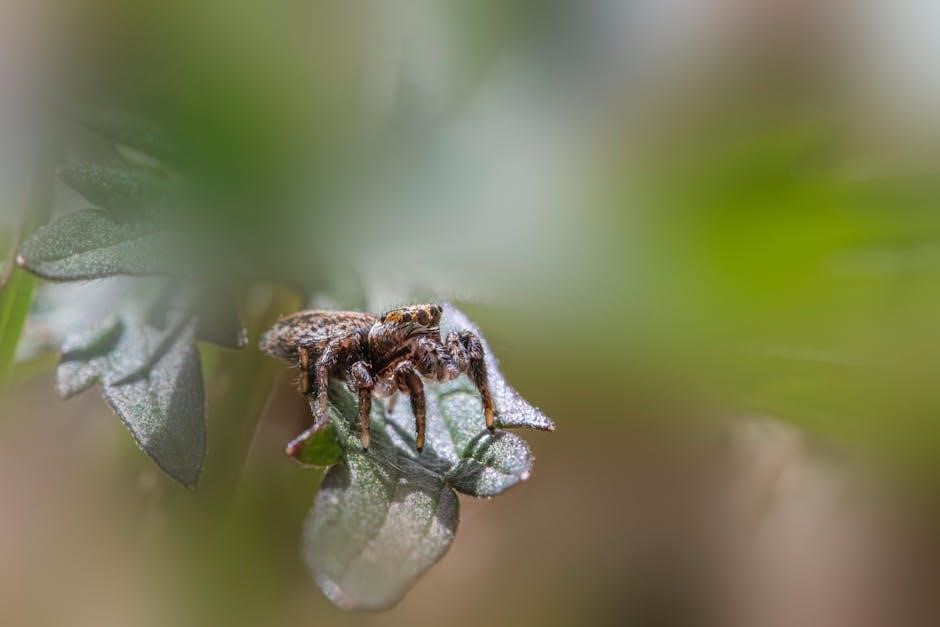
Supplements and Nutritional Needs
Jumping spiders benefit from calcium and vitamin supplements added to their prey, ensuring proper growth and health. Avoid over-supplementation to prevent potential harm to your pet.
5.1. Calcium and Vitamin Supplements for Insects
Providing live insects dusted with calcium and vitamin supplements ensures jumping spiders receive essential nutrients. This practice supports strong exoskeleton development and overall health, especially during molting. Regular supplementation helps prevent deficiencies, promoting vitality and active behavior in pet jumping spiders. Always use high-quality, pet-safe powders for optimal results and your spider’s well-being.
5.2. Avoiding Over-Supplementation
Over-supplementation can harm jumping spiders by causing nutritional imbalances and organ damage. It’s crucial to follow recommended dosages and avoid frequent use of calcium and vitamins. Overdusting insects can lead to health issues, so moderation is key. Ensure supplements are used sparingly and only when necessary to maintain your spider’s optimal health and prevent potential harm from excessive nutrient intake.
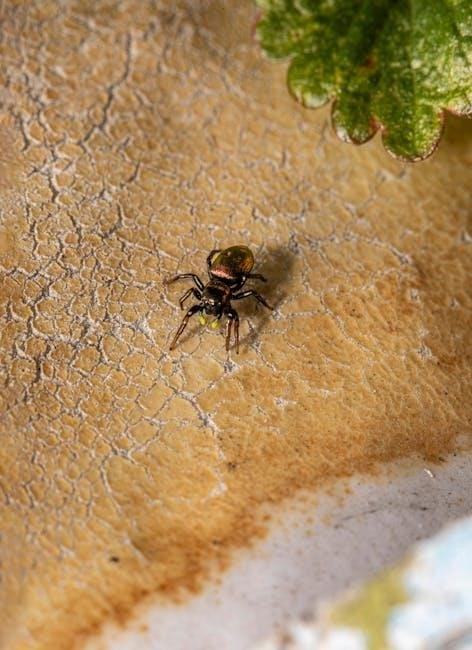
Feeding Live Prey: Best Practices
Feed live prey that matches your spider’s size and appetite. Avoid large or aggressive insects that could harm your pet. Use tweezers for safe, controlled feeding.
6.1. Ensuring Prey is Appropriately Sized
Always select prey no larger than 1.5 times your jumping spider’s body size to prevent harm. Smaller insects like fruit flies suit young spiders, while adults can handle crickets or roaches. Properly sized prey ensures safe feeding and prevents stress, promoting healthy digestion and growth. This practice is crucial for maintaining your pet’s well-being and vitality over time.
6.2. Avoiding Prey That Is Too Large or Aggressive
Avoid offering prey that exceeds 1.5 times your spider’s body size, as it may cause stress or injury. Aggressive insects, like large roaches or hyperactive crickets, can also harm your spider. Stick to calm, appropriately sized feeder insects to ensure safe and stress-free feeding. Observing your spider’s behavior during meals helps identify if the prey is too challenging or unsuitable for them.
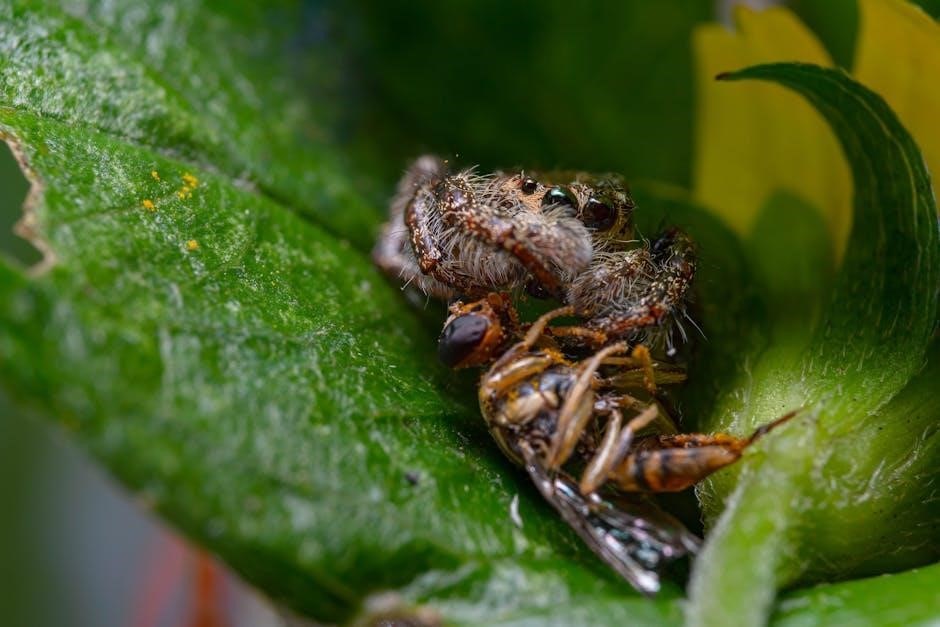
Feeding Fruits and Sweet Treats
Jumping spiders enjoy fruits like watermelon and strawberries as sweet treats. Fresh fruits provide essential nutrients and energy, serving as a supplement to their insect-based diet.
7.1. Offering Fresh Fruits Like Watermelon and Strawberries
Fresh fruits such as watermelon and strawberries make excellent occasional treats for jumping spiders. These fruits are high in natural sugars, offering a quick energy boost. Slice them thinly and place in a feeding dish to prevent mess. Avoid overripe fruits to ensure they remain fresh and palatable for your spider. This supplement supports their overall health and vitality.
7.2. Providing Nectar as an Occasional Treat
Nectar is a delightful treat for jumping spiders, offering a concentrated source of energy. Dilute commercial nectar with water to prevent overpowering sweetness. Using a feeding dish, place a small amount near your spider. This supplement is ideal for special occasions, providing a sugary boost without replacing their primary insect-based diet. It keeps them lively and satisfied between meals.
Monitoring Feeding Behavior
Observe your jumping spider’s appetite and activity during meals. Note reluctant approaches to food or changes in posture, indicating satiety or disinterest. Track uneaten prey to adjust portions and frequency, ensuring optimal nourishment without overfeeding. This helps maintain their health and energy levels, preventing issues like lethargy or weight gain.
8.1. Observing Spider’s Appetite and Activity
Monitor your jumping spider’s behavior during feeding sessions. Note if it actively approaches prey, indicating hunger, or ignores food, suggesting fullness. Observe how quickly it consumes prey and if it leaves leftovers, which can signal overfeeding. Adjust feeding schedules based on these cues to ensure proper nourishment without overwhelming the spider.
8.2. Adjusting Feeding Based on Spider’s Weight and Health
Regularly assess your jumping spider’s weight and overall health. A spider that appears underweight may need more frequent feedings, while an overweight one might require fewer meals. Signs of poor health, such as lethargy or loss of color, may indicate the need to adjust the diet or consult a specialist to ensure optimal care.
Common Feeding Mistakes to Avoid
Overfeeding can lead to health issues, while underfeeding may stunt growth. Using improper tools or techniques can stress the spider. Always monitor appetite and adjust portions accordingly;
9.1. Overfeeding or Underfeeding
Overfeeding can cause obesity, reducing activity and lifespan, while underfeeding leads to stunted growth and weakness. Monitor feeding frequency and portion sizes, adjusting according to the spider’s size, age, and appetite. Avoid offering prey too large or too small, ensuring meals are balanced and appropriate for the spider’s needs and life stage.
9.2. Using Improper Feeding Tools or Techniques
Using improper feeding tools or techniques can stress jumping spiders and lead to health issues. Avoid using bare hands or inappropriate objects, as they may harm the spider. Techniques like forcing food or failing to immobilize prey can cause injury. Always use recommended tools, such as tweezers or feeding dishes, to ensure safe and stress-free feeding experiences for your pet jumping spider.
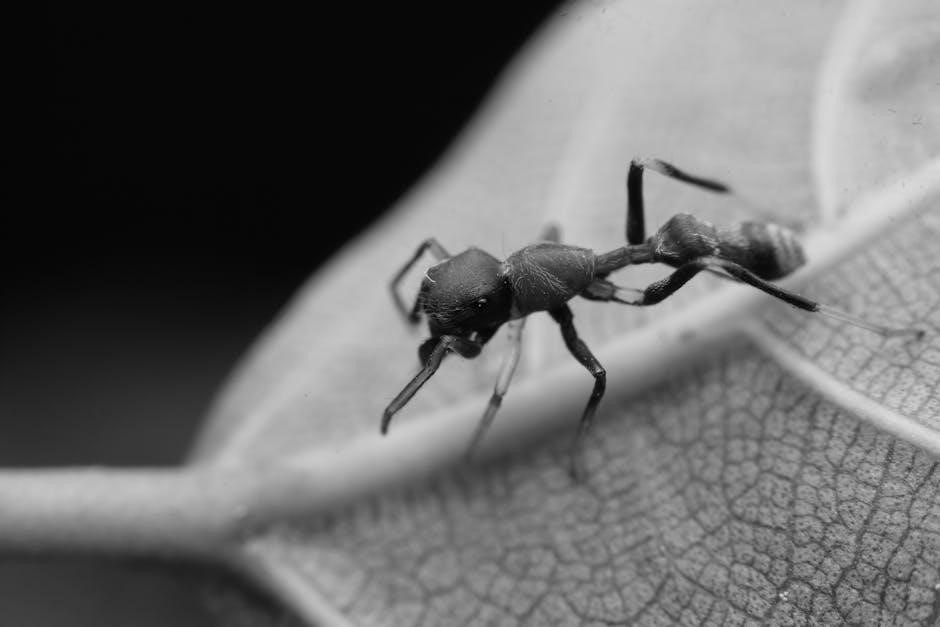
Feeding Juvenile Jumping Spiders
Juvenile jumping spiders require a high-protein diet for rapid growth. Feed them daily or every other day with small insects like fruit flies or tiny crickets. Avoid overfeeding to prevent health issues and stress.
10.1. High-Protein Diets for Growth
Juvenile jumping spiders need a high-protein diet to support rapid growth and molting. Feed them small, nutrient-rich insects like fruit flies, baby crickets, or pinhead roaches daily. Ensure portions are appropriate for their size to prevent overfeeding. Avoid large prey that could cause stress or harm. A consistent supply of protein-rich food ensures healthy development and energy for their active lifestyle.
10.2. Smaller and More Frequent Meals
Juvenile jumping spiders benefit from smaller, more frequent meals to support their rapid growth. Offer small prey like fruit flies or pinhead crickets daily or every other day. This ensures they receive adequate nutrition without overwhelming them. Smaller portions prevent waste and stress, while frequent feeding aligns with their high energy needs during development. This approach promotes healthy growth and vitality in young spiders.
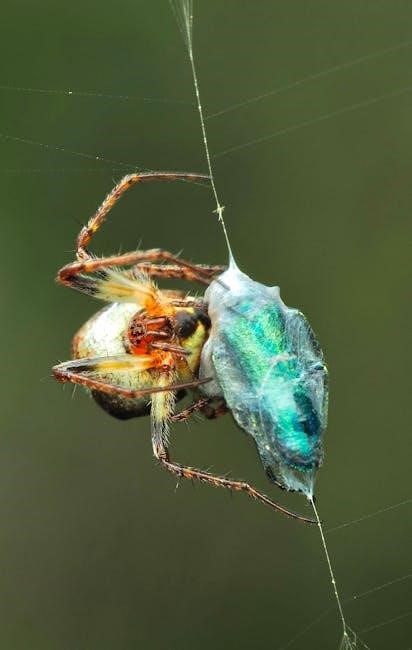
Recognizing Hunger and Satiety Cues
Recognizing hunger and satiety cues in jumping spiders is crucial. Hungry spiders exhibit agility and approach food readily, while satiated spiders remain still and disinterested.
11.1. Signs of Hunger in Jumping Spiders
Jumping spiders exhibit clear signs of hunger, such as increased movement, vibrational sensitivity, and active hunting behavior. They may also approach food more aggressively and rapidly when hungry. Observing these cues helps determine when to feed, ensuring their energy needs are met for optimal health and activity levels.
11.2. Signs of Fullness or Disinterest
Jumping spiders show clear signs of fullness or disinterest, such as stopping movement, losing interest in prey, or refusing food. They may also retreat or remain still, indicating satiety. Recognizing these cues helps avoid overfeeding and ensures a balanced diet, promoting overall health and preventing digestive issues in your pet spider.
Special Considerations for Different Species
Different jumping spider species have unique feeding requirements based on size, behavior, and habitat. Larger species may need bigger prey, while smaller ones require more frequent meals.
12.1. Species-Specific Feeding Preferences
Species like Phidippus regius prefer crickets and flies, while others may favor roaches or waxworms. Smaller species often eat fruit flies, and larger ones may enjoy mealworms. Observing individual preferences ensures optimal nutrition and satisfaction for each spider, promoting healthy growth and energy levels.
12.2. Adjusting Diets for Larger or Smaller Species
Larger jumping spider species may require bigger prey like roaches or mealworms, while smaller species thrive on tiny fruit flies or pinhead crickets. Adjusting prey size and feeding frequency ensures proper nutrition; For smaller spiders, more frequent, smaller meals are ideal, while larger species can handle less frequent, larger portions, promoting healthy growth and energy levels.
Feeding jumping spiders requires a balanced diet of live insects, proper tools, and observation. This guide provides essential practices to ensure your pet thrives happily and healthily.
13.1. Summary of Best Feeding Practices
Feed jumping spiders a variety of live insects like crickets and flies, ensuring prey is appropriately sized. Use feeding dishes or tweezers for convenience and safety. Adults should eat every 2-3 days, while juveniles require more frequent meals; Monitor appetite and weight to adjust feeding schedules. Provide occasional fruit or nectar as treats. Avoid overfeeding and observe hunger cues for optimal care.
13.2. Final Tips for Successful Jumping Spider Care
Observe your spider’s behavior to tailor feeding and care. Maintain a clean environment and ensure proper ventilation. Be patient, as feeding responses can vary. Provide enrichment like plants or substrate for stimulation. Handle gently and briefly, especially for young spiders. Ensure a secure enclosure to prevent escape attempts. With consistent care and attention, your jumping spider will thrive and remain a fascinating companion.
